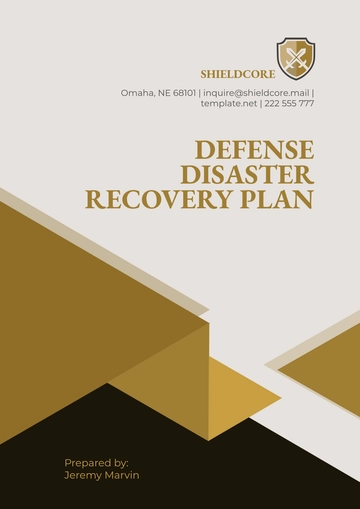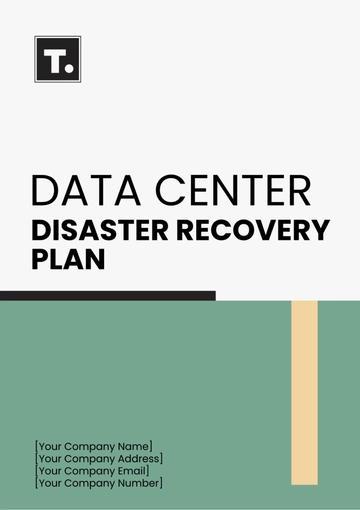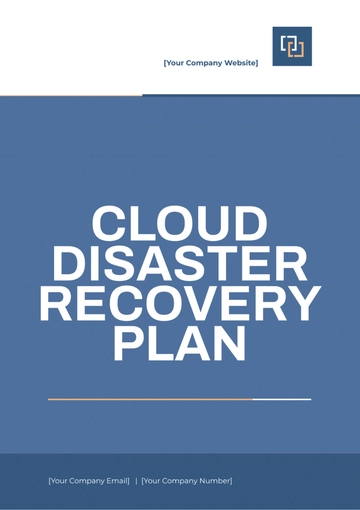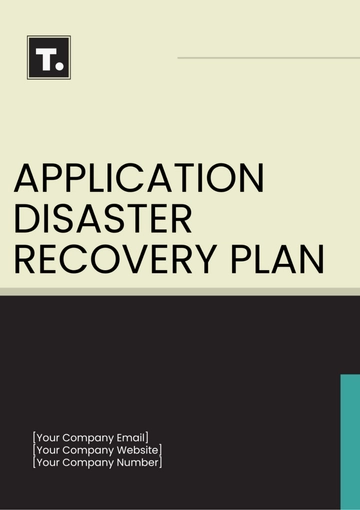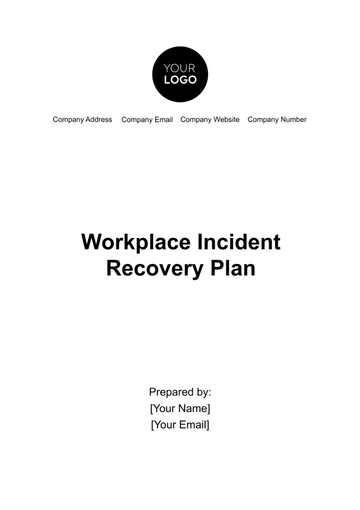Free IT Disaster Recovery Plan

1. Introduction
1.1 Purpose
The IT Disaster Recovery Plan (DRP) for [Your Company Name] is a strategic framework designed to ensure the resilience of our IT infrastructure and continuity of business operations in the event of a significant disruption or disaster. This plan serves to prepare for, respond to, and recover from incidents that could impact the availability, integrity, or confidentiality of our IT systems and data. By implementing this DRP, [Your Company Name] aims to:
Ensure Business Continuity: Maintain or quickly resume critical business functions with minimal disruption.
Protect Critical Assets: Safeguard data, systems, and resources essential for operational integrity.
Maintain Regulatory Compliance: Adhere to industry standards and legal requirements for disaster preparedness and data protection.
Enhance Recovery Capabilities: Develop and refine procedures to improve recovery speed and efficiency.
1.2 Scope
The scope of this IT Disaster Recovery Plan encompasses all IT-related assets and services within [Your Company Name], including:
Data Centers: Physical facilities housing servers, storage, and networking equipment.
Network Infrastructure: Routers, switches, firewalls, and other network devices.
Servers and Storage: Both physical and virtual servers, as well as storage systems for data.
Applications: Critical business applications, including ERP systems, CRM tools, and custom applications.
End-User Systems: Computers, mobile devices, and other technology used by employees.
Third-Party Services: External vendors and service providers crucial to IT operations, including cloud services and managed IT services.
1.3 Objectives
The objectives of the IT Disaster Recovery Plan are:
Minimize Downtime: Implement strategies to reduce the duration of service interruptions and maintain operational continuity.
Ensure Data Integrity: Protect data from loss or corruption and ensure its accuracy and availability during recovery.
Facilitate Communication: Establish effective communication protocols to keep all stakeholders informed and coordinated.
Achieve Compliance: Fulfill all legal and regulatory obligations related to disaster recovery and data protection.
Continuous Improvement: Regularly review and enhance the DRP to address new risks and incorporate best practices.
2. Risk Assessment
2.1 Identifying Risks
A comprehensive risk assessment helps identify and evaluate potential threats that could disrupt IT operations at [Your Company Name]. Common risks include:
Natural Disasters: Events such as earthquakes, floods, hurricanes, and tornadoes that can cause physical damage to IT infrastructure and facilities.
Cyber Attacks: Malicious activities such as ransomware, phishing, denial-of-service attacks, and data breaches that threaten the security and functionality of IT systems.
Hardware Failures: Failures of physical components such as servers, hard drives, or network devices that can lead to data loss or system outages.
Human Error: Mistakes or inadvertent actions by employees or contractors that can result in data corruption, system misconfigurations, or other issues.
Power Outages: Interruptions in electrical power that can affect the operation of data centers and IT equipment, leading to potential system downtime.
Third-Party Failures: Disruptions or failures by external vendors or service providers that impact their ability to deliver essential services or support.
2.2 Risk Impact Analysis
Analyzing the impact of identified risks helps prioritize recovery efforts and allocate resources effectively. Key aspects of impact analysis include:
Operational Impact: Assess how the risk affects daily business operations, including customer service, production, and internal processes.
Financial Impact: Estimate the financial losses associated with the risk, including lost revenue, recovery costs, and potential fines or penalties.
Reputation Impact: Evaluate the potential damage to [Your Company Name]’s reputation and customer trust, which can affect long-term business relationships.
Legal and Compliance Impact: Identify any legal or regulatory implications, including non-compliance penalties and legal liabilities.
2.3 Risk Mitigation Strategies
To mitigate risks and reduce their potential impact, [Your Company Name] employs a range of strategies:
Redundancy: Implement redundant systems, including backup servers, storage solutions, and network components, to ensure continuity in the event of a failure.
Security Measures: Employ comprehensive cybersecurity protocols, including encryption, access controls, and threat detection systems, to protect against cyber threats.
Training and Awareness: Provide ongoing training for employees to increase awareness of disaster recovery procedures, security practices, and emergency response.
Backup Procedures: Establish a rigorous backup schedule, ensuring data is regularly backed up and stored securely off-site or in the cloud.
Vendor Management: Monitor and evaluate third-party service providers to ensure they meet performance standards and have their own disaster recovery plans in place.
3. Disaster Recovery Team
3.1 Roles and Responsibilities
The Disaster Recovery Team (DRT) is responsible for executing the IT Disaster Recovery Plan and managing the recovery process. Key roles and responsibilities include:
Disaster Recovery Coordinator: Leads the disaster recovery efforts, coordinates activities, and serves as the primary point of contact. Responsibilities include overseeing plan activation, resource allocation, and communication with stakeholders.
IT Systems Manager: Oversees the recovery of IT systems, including servers, databases, and applications. Ensures that systems are restored to operational status and verifies that functionality meets business requirements.
Network Administrator: Manages network recovery, including the restoration of connectivity and configuration of network devices. Addresses any network-related issues that arise during the recovery process.
Data Backup Specialist: Manages data backups and restoration processes. Ensures that backup data is accessible, complete, and accurately restored to minimize data loss.
Communications Officer: Handles communication with internal and external stakeholders. Provides regular updates on recovery progress, incident status, and any changes to operations.
Facilities Manager: Oversees the physical aspects of recovery, including repairing or replacing damaged infrastructure, such as data centers and office spaces. Ensures that the physical environment is safe and operational.
4. Disaster Recovery Procedures
4.1 Activation of the Plan
The IT Disaster Recovery Plan is activated when a disaster or significant disruption is confirmed. The activation process includes:
Initial Assessment: Evaluate the situation to determine the extent of the impact, affected systems, and the need for immediate recovery actions.
Notification: Inform the Disaster Recovery Team and key stakeholders about the situation and the activation of the recovery plan. Use predefined communication channels to ensure timely notifications.
Mobilization: Deploy the Disaster Recovery Team to begin implementing recovery procedures. Allocate resources and prioritize actions based on the severity and impact of the incident.
4.2 Recovery Phases
The recovery process is structured into distinct phases to ensure a systematic approach:
Immediate Response: Address immediate concerns to stabilize the situation. Actions may include shutting down affected systems, securing physical areas, and addressing any safety concerns.
Damage Assessment: Conduct a thorough assessment of the damage to IT infrastructure. Identify which systems, applications, and data have been impacted and determine the scope of recovery efforts required.
Recovery Operations: Execute recovery procedures to restore IT services and systems. This includes restoring data from backups, repairing or replacing hardware, and reconfiguring network settings.
Post-Recovery Review: After recovery operations are complete, conduct a review to evaluate the effectiveness of the recovery efforts. Document lessons learned, identify areas for improvement, and update the disaster recovery plan accordingly.
4.3 Data Backup and Restoration
Data backup and restoration are critical components of disaster recovery. The procedures include:
Backup Schedule: Perform backups on a regular schedule to ensure data is up-to-date. This includes daily incremental backups and weekly full backups. Store backups securely in off-site locations or cloud storage.
Backup Verification: Regularly test and verify backups to ensure data integrity and completeness. Conduct periodic restoration tests to confirm that backups can be successfully restored.
Data Restoration: During a disaster, restore data from backups to recover lost or corrupted information. This involves selecting the appropriate backup version and ensuring data is accurately restored to its pre-disaster state.
4.4 System Restoration
Restoring IT systems involves several steps:
Hardware Replacement: Replace or repair damaged hardware components, including servers, storage devices, and network equipment. Ensure that replacements meet the required specifications and compatibility.
Software Reinstallation: Reinstall operating systems, applications, and configurations on recovered or replaced hardware. Verify that software is up-to-date and correctly configured.
System Testing: Perform comprehensive testing of restored systems to ensure they are functioning correctly and meeting performance standards. Address any issues or anomalies identified during testing.
Application Recovery: Restore and validate the functionality of critical applications used by [Your Company Name]. Ensure that applications are fully operational and that data integrity is maintained.
4.5 Communication Plan
Effective communication is essential during a disaster. The communication plan includes:
Internal Communication: Keep employees informed about the status of recovery efforts, expected downtime, and any changes to normal operations. Use email, intranet, and other internal communication channels.
External Communication: Provide updates to customers, vendors, and other external stakeholders regarding the impact of the disaster and recovery progress. Use official channels such as company websites, social media, and press releases.
Media Relations: Manage media inquiries and provide accurate, timely information to maintain transparency and protect the company’s reputation. Designate a spokesperson to handle media interactions and address any concerns.
5. Testing and Maintenance
5.1 Testing Procedures
Regular testing of the disaster recovery plan is crucial for ensuring its effectiveness. Testing procedures include:
Tabletop Exercises: Conduct simulated scenarios where the Disaster Recovery Team reviews and discusses their response to hypothetical disasters. Tabletop exercises help identify gaps in the plan and improve team coordination.
Technical Tests: Perform technical tests to validate backup and restoration procedures. This includes verifying that backup systems are functional and that data can be restored successfully.
Full-Scale Drills: Execute full-scale drills that involve all aspects of the disaster recovery plan. These drills simulate real-life scenarios and test the team’s ability to manage recovery efforts from start to finish.
5.2 Plan Maintenance
Maintaining the disaster recovery plan ensures it remains relevant and effective. Maintenance tasks include:
Review Schedule: Schedule regular reviews of the disaster recovery plan, at least annually, to ensure it reflects current technology, business processes, and risk assessments.
Update Procedures: Revise procedures and documentation as needed to address changes in technology, organizational structure, and regulatory requirements. Ensure that all updates are communicated to relevant stakeholders.
Document Changes: Keep a record of all changes made to the disaster recovery plan, including the date of each update, the reasons for the changes, and any affected procedures.
5.3 Continuous Improvement
To enhance the disaster recovery plan, [Your Company Name] should:
Evaluate Performance: Assess the performance of the disaster recovery plan during tests and actual incidents. Analyze the effectiveness of recovery efforts and identify any areas for improvement.
Incorporate Feedback: Collect feedback from Disaster Recovery Team members and other stakeholders to refine procedures and address any identified issues.
Adopt Best Practices: Stay informed about industry best practices and emerging trends in disaster recovery. Incorporate new techniques and technologies to improve the plan’s effectiveness and resilience.
6. Compliance and Documentation
6.1 Regulatory Requirements
Compliance with regulatory requirements is essential for disaster recovery and data protection. [Your Company Name] must adhere to:
Data Protection Laws: Comply with laws and regulations related to the protection of personal and sensitive data. This includes regulations such as GDPR, CCPA, and others relevant to our operations.
Industry Standards: Follow industry standards and guidelines for disaster recovery and business continuity. This includes standards such as ISO/IEC 27001 for information security management and ISO/IEC 22301 for business continuity management.
6.2 Documentation
Accurate documentation is critical for effective disaster recovery. Essential documentation includes:
Disaster Recovery Plan: The complete and up-to-date version of the IT Disaster Recovery Plan, including all procedures, roles, and responsibilities.
Contact Lists: Updated contact information for the Disaster Recovery Team, stakeholders, and external vendors. Ensure that contact lists are readily accessible and regularly updated.
Backup Records: Detailed records of backup schedules, storage locations, and verification results. Maintain documentation of backup procedures and any issues encountered.
6.3 Record Keeping
Maintaining records of disaster recovery activities is important for accountability and improvement. Records should include:
Incident Reports: Detailed reports of disaster incidents, including the nature of the incident, actions taken, and the outcome. Use these reports to analyze the response and identify areas for improvement.
Test Results: Results of disaster recovery tests and exercises, including any issues identified and corrective actions taken. Use these results to evaluate the effectiveness of the plan and guide future improvements.
Plan Updates: Documentation of changes made to the disaster recovery plan, including the rationale for each update and the date of implementation.
Table: Disaster Recovery Plan Contact Information
Role | Name | Phone Number | |
|---|---|---|---|
Disaster Recovery Coordinator | [Name] | [Email] | [Phone Number] |
IT Systems Manager | [Name] | [Email] | [Phone Number] |
Network Administrator | [Name] | [Email] | [Phone Number] |
Data Backup Specialist | [Name] | [Email] | [Phone Number] |
Communications Officer | [Name] | [Email] | [Phone Number] |
Facilities Manager | [Name] | [Email] | [Phone Number] |
Table: Backup Schedule
Backup Type | Frequency | Backup Location | Verification Schedule |
|---|---|---|---|
Full Backup | Weekly | Off-Site Cloud | Monthly |
Incremental Backup | Daily | Off-Site Cloud | Weekly |
Application Backup | Weekly | On-Site Storage | Monthly |
- 100% Customizable, free editor
- Access 1 Million+ Templates, photo’s & graphics
- Download or share as a template
- Click and replace photos, graphics, text, backgrounds
- Resize, crop, AI write & more
- Access advanced editor
Ensure business continuity with the IT Disaster Recovery Plan Template from Template.net. This editable and customizable template enables you to develop a robust recovery plan. Personalize it easily in our Ai Editor Tool for swift disaster response and recovery strategies.
You may also like
- Finance Plan
- Construction Plan
- Sales Plan
- Development Plan
- Career Plan
- Budget Plan
- HR Plan
- Education Plan
- Transition Plan
- Work Plan
- Training Plan
- Communication Plan
- Operation Plan
- Health And Safety Plan
- Strategy Plan
- Professional Development Plan
- Advertising Plan
- Risk Management Plan
- Restaurant Plan
- School Plan
- Nursing Home Patient Care Plan
- Nursing Care Plan
- Plan Event
- Startup Plan
- Social Media Plan
- Staffing Plan
- Annual Plan
- Content Plan
- Payment Plan
- Implementation Plan
- Hotel Plan
- Workout Plan
- Accounting Plan
- Campaign Plan
- Essay Plan
- 30 60 90 Day Plan
- Research Plan
- Recruitment Plan
- 90 Day Plan
- Quarterly Plan
- Emergency Plan
- 5 Year Plan
- Gym Plan
- Personal Plan
- IT and Software Plan
- Treatment Plan
- Real Estate Plan
- Law Firm Plan
- Healthcare Plan
- Improvement Plan
- Media Plan
- 5 Year Business Plan
- Learning Plan
- Marketing Campaign Plan
- Travel Agency Plan
- Cleaning Services Plan
- Interior Design Plan
- Performance Plan
- PR Plan
- Birth Plan
- Life Plan
- SEO Plan
- Disaster Recovery Plan
- Continuity Plan
- Launch Plan
- Legal Plan
- Behavior Plan
- Performance Improvement Plan
- Salon Plan
- Security Plan
- Security Management Plan
- Employee Development Plan
- Quality Plan
- Service Improvement Plan
- Growth Plan
- Incident Response Plan
- Basketball Plan
- Emergency Action Plan
- Product Launch Plan
- Spa Plan
- Employee Training Plan
- Data Analysis Plan
- Employee Action Plan
- Territory Plan
- Audit Plan
- Classroom Plan
- Activity Plan
- Parenting Plan
- Care Plan
- Project Execution Plan
- Exercise Plan
- Internship Plan
- Software Development Plan
- Continuous Improvement Plan
- Leave Plan
- 90 Day Sales Plan
- Advertising Agency Plan
- Employee Transition Plan
- Smart Action Plan
- Workplace Safety Plan
- Behavior Change Plan
- Contingency Plan
- Continuity of Operations Plan
- Health Plan
- Quality Control Plan
- Self Plan
- Sports Development Plan
- Change Management Plan
- Ecommerce Plan
- Personal Financial Plan
- Process Improvement Plan
- 30-60-90 Day Sales Plan
- Crisis Management Plan
- Engagement Plan
- Execution Plan
- Pandemic Plan
- Quality Assurance Plan
- Service Continuity Plan
- Agile Project Plan
- Fundraising Plan
- Job Transition Plan
- Asset Maintenance Plan
- Maintenance Plan
- Software Test Plan
- Staff Training and Development Plan
- 3 Year Plan
- Brand Activation Plan
- Release Plan
- Resource Plan
- Risk Mitigation Plan
- Teacher Plan
- 30 60 90 Day Plan for New Manager
- Food Safety Plan
- Food Truck Plan
- Hiring Plan
- Quality Management Plan
- Wellness Plan
- Behavior Intervention Plan
- Bonus Plan
- Investment Plan
- Maternity Leave Plan
- Pandemic Response Plan
- Succession Planning
- Coaching Plan
- Configuration Management Plan
- Remote Work Plan
- Self Care Plan
- Teaching Plan
- 100-Day Plan
- HACCP Plan
- Student Plan
- Sustainability Plan
- 30 60 90 Day Plan for Interview
- Access Plan
- Site Specific Safety Plan

